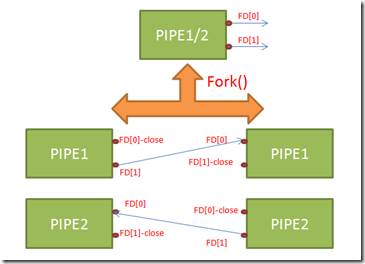父子进程可以通过管道进行数据交互,一个管道只能有一个数据流向,要实现双工通信,可以使用两个管道实现。
管道工作原理:
- 向内核申请管道描述符
- 父子进程fork()后均有该管道资源,但处于不同内存地址
- 通过对描述符读写实现通信
数据交互图:
单工通信代码实现:
1 #include <stdio.h> 2 #include <string.h> 3 #include <unistd.h> 4 #include <iostream> 5 6 using namespace std; 7 8 const int MAX_BUFFSIZE = 1024; 9 10 int main() 11 { 12 int pipe_fd[2]; 13 pid_t pid; 14 char buff[MAX_BUFFSIZE]; 15 16 memset(buff,'�',sizeof(buff)); 17 18 if (pipe(pipe_fd) < 0) 19 { 20 cout<<"pipe create error"; 21 } 22 23 if ((pid = fork()) < 0) 24 { 25 cout<<"fork error"; 26 } 27 28 if (pid > 0) 29 { 30 close(pipe_fd[0]); 31 cin>>buff; 32 write(pipe_fd[1],buff,sizeof(buff)); 33 } 34 if (pid == 0) 35 { 36 close(pipe_fd[1]); 37 if ((read(pipe_fd[0],buff,MAX_BUFFSIZE)) > 0) 38 { 39 cout<<"Msg from parent:"<<buff; 40 } 41 } 42 return 0; 43 }测试结果:

